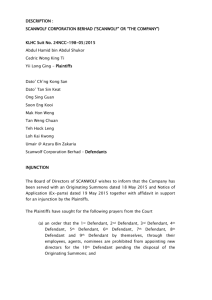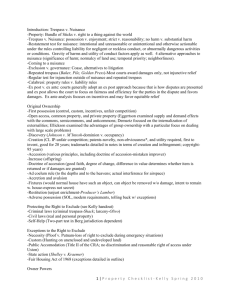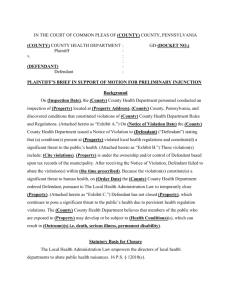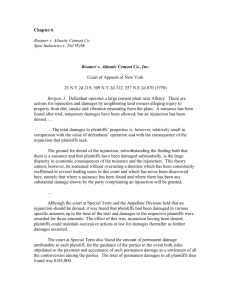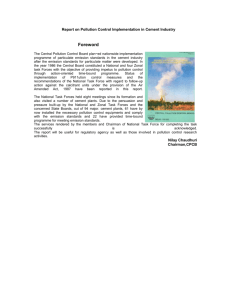BOOMER v. ATLANTIC CEMENT CO.
advertisement
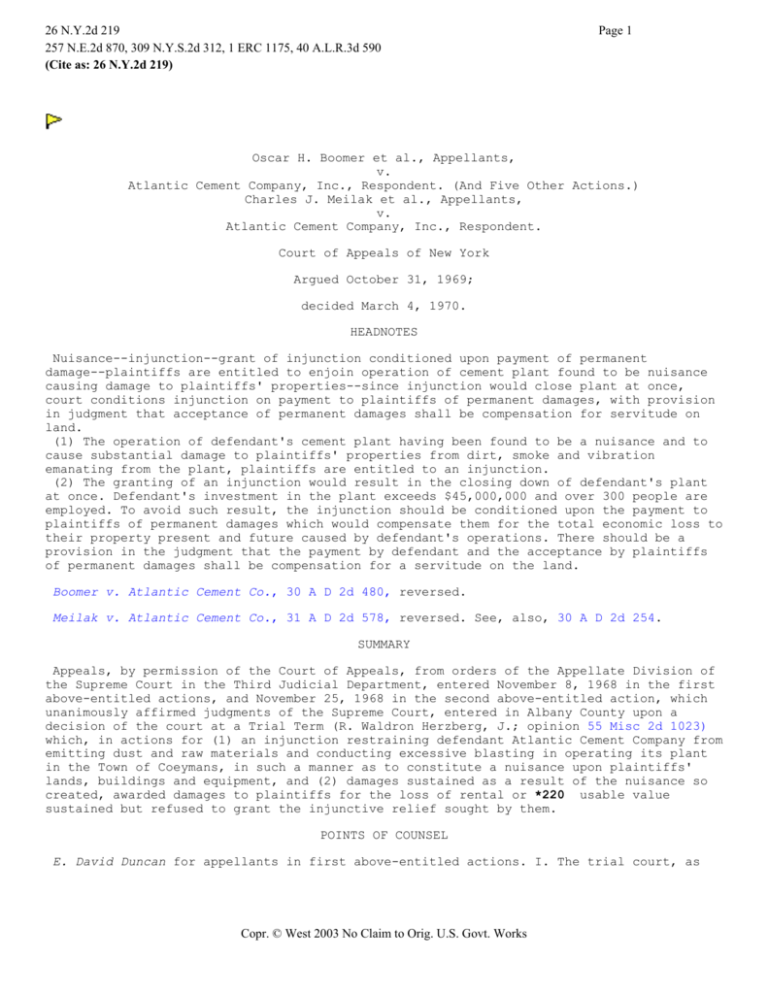
26 N.Y.2d 219 257 N.E.2d 870, 309 N.Y.S.2d 312, 1 ERC 1175, 40 A.L.R.3d 590 (Cite as: 26 N.Y.2d 219) Page 1 Oscar H. Boomer et al., Appellants, v. Atlantic Cement Company, Inc., Respondent. (And Five Other Actions.) Charles J. Meilak et al., Appellants, v. Atlantic Cement Company, Inc., Respondent. Court of Appeals of New York Argued October 31, 1969; decided March 4, 1970. HEADNOTES Nuisance--injunction--grant of injunction conditioned upon payment of permanent damage--plaintiffs are entitled to enjoin operation of cement plant found to be nuisance causing damage to plaintiffs' properties--since injunction would close plant at once, court conditions injunction on payment to plaintiffs of permanent damages, with provision in judgment that acceptance of permanent damages shall be compensation for servitude on land. (1) The operation of defendant's cement plant having been found to be a nuisance and to cause substantial damage to plaintiffs' properties from dirt, smoke and vibration emanating from the plant, plaintiffs are entitled to an injunction. (2) The granting of an injunction would result in the closing down of defendant's plant at once. Defendant's investment in the plant exceeds $45,000,000 and over 300 people are employed. To avoid such result, the injunction should be conditioned upon the payment to plaintiffs of permanent damages which would compensate them for the total economic loss to their property present and future caused by defendant's operations. There should be a provision in the judgment that the payment by defendant and the acceptance by plaintiffs of permanent damages shall be compensation for a servitude on the land. Boomer v. Atlantic Cement Co., 30 A D 2d 480, reversed. Meilak v. Atlantic Cement Co., 31 A D 2d 578, reversed. See, also, 30 A D 2d 254. SUMMARY Appeals, by permission of the Court of Appeals, from orders of the Appellate Division of the Supreme Court in the Third Judicial Department, entered November 8, 1968 in the first above-entitled actions, and November 25, 1968 in the second above-entitled action, which unanimously affirmed judgments of the Supreme Court, entered in Albany County upon a decision of the court at a Trial Term (R. Waldron Herzberg, J.; opinion 55 Misc 2d 1023) which, in actions for (1) an injunction restraining defendant Atlantic Cement Company from emitting dust and raw materials and conducting excessive blasting in operating its plant in the Town of Coeymans, in such a manner as to constitute a nuisance upon plaintiffs' lands, buildings and equipment, and (2) damages sustained as a result of the nuisance so created, awarded damages to plaintiffs for the loss of rental or *220 usable value sustained but refused to grant the injunctive relief sought by them. POINTS OF COUNSEL E. David Duncan for appellants in first above-entitled actions. I. The trial court, as Copr. © West 2003 No Claim to Orig. U.S. Govt. Works 26 N.Y.2d 219 257 N.E.2d 870, 309 N.Y.S.2d 312, 1 ERC 1175, 40 A.L.R.3d 590 (Cite as: 26 N.Y.2d 219) Page 2 well as the Appellate Division, erred as a matter of law by depriving plaintiffs of their property rights when the courts failed to grant an injunction against the nuisances created by The Atlantic Cement Company, Inc. (Campbell v. Seaman, 63 N. Y. 568; Whalen v. Union Bag & Paper Co., 208 N. Y. 1; Strobel v. Kerr Salt Co., 164 N. Y. 303; Stowers v. Gilbert, 156 N. Y. 600; Pappenheim v. Metropolitan El. Ry. Co., 128 N. Y. 436; Hulbert v. California Portland Cement Co., 161 Cal. 239; McCann v. Chasm Power Co., 211 N. Y. 301; Forstmann v. Joray Holding Co., 244 N. Y. 22; Howland v. Union Bag & Paper Corp., 156 Misc. 507; Wormser v. Brown, 149 N. Y. 163.) II. The trial court and Appellate Division in our instant cases have devised a new "economic utility doctrine", which if left unchallenged will leave in jeopardy the rights of small property owners throughout the State of New York. III. The trial court and the Appellate Division erred in their decision by leaving plaintiffs with an inadequate remedy at law, which results in a multiplicity of suits. (Campbell v. Seaman, 63 N. Y. 568; Henderson v. New York Cent. R. R. Co., 78 N. Y. 423; Madison Ave. Baptist Church v. Baptist Church in Oliver St., 73 N. Y. 82.) IV. The lower courts erroneously based their limitation on the scope of damages that could be awarded. (Uline v. New York Cent. & Hudson Riv. R. R. Co., 101 N. Y. 98; Francis v. Schoellkopf, 53 N. Y. 152; Henderson v. New York Cent. R. R. Co., 78 N. Y. 423.) V. The temporary damages granted by the trial court to plaintiffs were inadequate. (Reisert v. City of New York, 174 N. Y. 196; Bates v. Holbrook, 89 App. Div. 548; Bohan v. Port Jervis Gaslight Co., 122 N. Y. 18.) VI. The reasonable market value of the real property of plaintiffs and of the business known as the Coach House Restaurant as well as the permanent damage found by the trial court were grossly inadequate as a matter of law. Daniel H. Prior, Jr. and John J. Biscone for appellants in second above- entitled action. I. It was error of law for the trial court and the Appellate Division to deny a permanent injunction to plaintiffs. (*221Forstmann v. Joray Holding Co., 244 N. Y. 22; Howland v. Union Bag & Paper Corp., 156 Misc. 507; McCann v. Chasm Power Co., 211 N. Y. 301; Squaw Is. Frgt. Term. Co. v. City of Buffalo, 246 App. Div. 472; Whalen v. Union Bag & Paper Co., 208 N. Y. 1; Spano v. Perini Corp., 25 N Y 2d 11; Hay v. Cohoes Co., 2 N Y 159.) II. The trial court and the Appellate Division, by its affirmance, erroneously held that plaintiffs' damages were limited to loss of rental value. (Uline v. New York Cent. & Hudson Riv. R. R. Co., 101 N. Y. 98; Francis v. Schoellkopf, 53 N. Y. 152; Hoffman v. Edison Elec. Illuminating Co., 87 App. Div. 371; Henderson v. New York Cent. R. R. Co., 78 N. Y. 423; Kilbourne v. Board of Supervisors of Sullivan County, 137 N. Y. 170; Campbell v. Seaman, 63 N. Y. 568; Baumann v. City of New York, 180 App. Div. 498.) Thomas F. Tracy and Frank J. Warner, Jr. for respondent. I. The appeals should be dismissed since they do not raise any questions which are reviewable by this court. (Matter of Seagram & Sons v. Tax Comm. of City of N. Y., 14 N Y 2d 314; Bethlehem Steel Co. v. Turner Constr. Co., 2 N Y 2d 456; St. Agnes Cemetery v. State of New York, 3 N Y 2d 37; Zipprich v. Smith Trucking Co., 2 N Y 2d 177; Serano v. New York Cent. & Hudson Riv. R. R. Co., 188 N. Y. 156; Dimon v. New York Cent. & Hudson Riv. R. R. Co., 173 N. Y. 356; Flagg v. Nichols, 307 N. Y. 96; Caponigri v. Altieri, 165 N. Y. 255.) II. The trial court properly found that a permanent injunction should not be granted. (Bentley v. Empire Portland Cement Co., 48 Misc. 457; Canfield v. Quayle, 170 Misc. 621; Andrews v. Perry, 127 Misc. 320; Strobel v. Kerr Salt Co., 164 N. Y. 303; Whalen v. Union Bag & Paper Co., 208 N. Y. 1.) III. The rule of damages applied by the trial court and the Appellate Division was correct. (Uline v. New York Cent. & Hudson Riv. R. R. Co., 101 N. Y. 98; Henderson v. New York Cent. R. R. Co., 78 N. Y. 423; Williams v. New York Cent. R. R. Co., 16 N. Y. 97; Pappenheim v. Metropolitan El. Ry. Co., 128 N. Y. 436; Lynch v. Metropolitan El. Ry. Co., 129 N. Y. 274; Westphal v. City of New York, 177 N. Y. 140; Ferguson v. Village of Hamburg, 272 N. Y. 234; Jamaica Sav. Bank v. M. S. Investing Co., 274 N. Y. 215.) IV. The questions of damages, including their adequacy, was properly determined in the court below. (Fitzgerald v. New York Cent. R. R. Co., 215 App. Div. 1; *222Jamaica Sav. Bank v. M. S. Investing Co., 274 N. Y. 215; Uline v. New York Cent. & Hudson Riv. Copr. © West 2003 No Claim to Orig. U.S. Govt. Works 26 N.Y.2d 219 257 N.E.2d 870, 309 N.Y.S.2d 312, 1 ERC 1175, 40 A.L.R.3d 590 (Cite as: 26 N.Y.2d 219) Page 3 R. R. Co., 101 N. Y. 98; Francis v. Schoellkopf, 53 N. Y. 152; Hoffman v. Edison Elec. Illuminating Co., 87 App. Div. 371; Tubiola v. Baker, 225 App. Div. 420; Matter of Sebring, 238 App. Div. 281.) OPINION OF THE COURT Bergan, J. Defendant operates a large cement plant near Albany. These are actions for injunction and damages by neighboring land owners alleging injury to property from dirt, smoke and vibration emanating from the plant. A nuisance has been found after trial, temporary damages have been allowed; but an injunction has been denied. The public concern with air pollution arising from many sources in industry and in transportation is currently accorded ever wider recognition accompanied by a growing sense of responsibility in State and Federal Governments to control it. Cement plants are obvious sources of air pollution in the neighborhoods where they operate. But there is now before the court private litigation in which individual property owners have sought specific relief from a single plant operation. The threshold question raised by the division of view on this appeal is whether the court should resolve the litigation between the parties now before it as equitably as seems possible; or whether, seeking promotion of the general public welfare, it should channel private litigation into broad public objectives. A court performs its essential function when it decides the rights of parties before it. Its decision of private controversies may sometimes greatly affect public issues. Large questions of law are often resolved by the manner in which private litigation is decided. But this is normally an incident to the court's main function to settle controversy. It is a rare exercise of judicial power to use a decision in private litigation as a purposeful mechanism to achieve direct public objectives greatly beyond the rights and interests before the court. Effective control of air pollution is a problem presently far from solution even with the full public and financial powers of government. In large measure adequate technical procedures are yet to be developed and some that appear possible may be economically impracticable. *223 It seems apparent that the amelioration of air pollution will depend on technical research in great depth; on a carefully balanced consideration of the economic impact of close regulation; and of the actual effect on public health. It is likely to require massive public expenditure and to demand more than any local community can accomplish and to depend on regional and interstate controls. A court should not try to do this on its own as a by-product of private litigation and it seems manifest that the judicial establishment is neither equipped in the limited nature of any judgment it can pronounce nor prepared to lay down and implement an effective policy for the elimination of air pollution. This is an area beyond the circumference of one private lawsuit. It is a direct responsibility for government and should not thus be undertaken as an incident to solving a dispute between property owners and a single cement plant -- one of many -- in the Hudson River valley. The cement making operations of defendant have been found by the court at Special Term to have damaged the nearby properties of plaintiffs in these two actions. That court, as it has been noted, accordingly found defendant maintained a nuisance and this has been affirmed at the Appellate Division. The total damage to plaintiffs' properties is, Copr. © West 2003 No Claim to Orig. U.S. Govt. Works 26 N.Y.2d 219 257 N.E.2d 870, 309 N.Y.S.2d 312, 1 ERC 1175, 40 A.L.R.3d 590 (Cite as: 26 N.Y.2d 219) Page 4 however, relatively small in comparison with the value of defendant's operation and with the consequences of the injunction which plaintiffs seek. The ground for the denial of injunction, notwithstanding the finding both that there is a nuisance and that plaintiffs have been damaged substantially, is the large disparity in economic consequences of the nuisance and of the injunction. This theory cannot, however, be sustained without overruling a doctrine which has been consistently reaffirmed in several leading cases in this court and which has never been disavowed here, namely that where a nuisance has been found and where there has been any substantial damage shown by the party complaining an injunction will be granted. The rule in New York has been that such a nuisance will be enjoined although marked disparity be shown in economic consequence between the effect of the injunction and the effect of the nuisance. *224 The problem of disparity in economic consequence was sharply in focus in Whalen v. Union Bag & Paper Co. (208 N. Y. 1). A pulp mill entailing an investment of more than a million dollars polluted a stream in which plaintiff, who owned a farm, was "a lower riparian owner". The economic loss to plaintiff from this pollution was small. This court, reversing the Appellate Division, reinstated the injunction granted by the Special Term against the argument of the mill owner that in view of "the slight advantage to plaintiff and the great loss that will be inflicted on defendant" an injunction should not be granted (p. 2). "Such a balancing of injuries cannot be justified by the circumstances of this case", Judge Werner noted (p. 4). He continued: "Although the damage to the plaintiff may be slight as compared with the defendant's expense of abating the condition, that is not a good reason for refusing an injunction" (p. 5). Thus the unconditional injunction granted at Special Term was reinstated. The rule laid down in that case, then, is that whenever the damage resulting from a nuisance is found not "unsubstantial", viz., $100 a year, injunction would follow. This states a rule that had been followed in this court with marked consistency (McCarty v. Natural Carbonic Gas Co., 189 N. Y. 40; Strobel v. Kerr Salt Co., 164 N. Y. 303; Campbell v. Seaman, 63 N. Y. 568). There are cases where injunction has been denied. McCann v. Chasm Power Co. (211 N. Y. 301) is one of them. There, however, the damage shown by plaintiffs was not only unsubstantial, it was non-existent. Plaintiffs owned a rocky bank of the stream in which defendant had raised the level of the water. This had no economic or other adverse consequence to plaintiffs, and thus injunctive relief was denied. Similar is the basis for denial of injunction in Forstmann v. Joray Holding Co. (244 N. Y. 22) where no benefit to plaintiffs could be seen from the injunction sought (p. 32). Thus if, within Whalen v. Union Bag & Paper Co. (supra.;) which authoritatively states the rule in New York, the damage to plaintiffs in these present cases from defendant's cement plant is "not unsubstantial", an injunction should follow. Although the court at Special Term and the Appellate Division held that injunction should be denied, it was found that plaintiffs *225 had been damaged in various specific amounts up to the time of the trial and damages to the respective plaintiffs were awarded for those amounts. The effect of this was, injunction having been denied, plaintiffs could maintain successive actions at law for damages thereafter as further damage was incurred. The court at Special Term also found the amount of permanent damage attributable to each plaintiff, for the guidance of the parties in the event both sides stipulated to the payment and acceptance of such permanent damage as a settlement of all the controversies among the parties. The total of permanent damages to all plaintiffs thus found was $185,000. This basis of adjustment has not resulted in any stipulation by the parties. Copr. © West 2003 No Claim to Orig. U.S. Govt. Works 26 N.Y.2d 219 257 N.E.2d 870, 309 N.Y.S.2d 312, 1 ERC 1175, 40 A.L.R.3d 590 (Cite as: 26 N.Y.2d 219) Page 5 This result at Special Term and at the Appellate Division is a departure from a rule that has become settled; but to follow the rule literally in these cases would be to close down the plant at once. This court is fully agreed to avoid that immediately drastic remedy; the difference in view is how best to avoid it. [FN*] FN* Respondent's investment in the plant is in excess of $45,000,000. There are over 300 people employed there. One alternative is to grant the injunction but postpone its effect to a specified future date to give opportunity for technical advances to permit defendant to eliminate the nuisance; another is to grant the injunction conditioned on the payment of permanent damages to plaintiffs which would compensate them for the total economic loss to their property present and future caused by defendant's operations. For reasons which will be developed the court chooses the latter alternative. If the injunction were to be granted unless within a short period -- e.g., 18 months -the nuisance be abated by improved methods, there would be no assurance that any significant technical improvement would occur. The parties could settle this private litigation at any time if defendant paid enough money and the imminent threat of closing the plant would build up the pressure on defendant. If there were no improved techniques found, there would inevitably be applications to the court at Special Term for extensions of time to perform on showing of good faith efforts to find such techniques. Moreover, techniques to eliminate dust and other annoying by-products of cement making are unlikely to be developed by *226 any research the defendant can undertake within any short period, but will depend on the total resources of the cement industry Nationwide and throughout the world. The problem is universal wherever cement is made. For obvious reasons the rate of the research is beyond control of defendant. If at the end of 18 months the whole industry has not found a technical solution a court would be hard put to close down this one cement plant if due regard be given to equitable principles. On the other hand, to grant the injunction unless defendant pays plaintiffs such permanent damages as may be fixed by the court seems to do justice between the contending parties. All of the attributions of economic loss to the properties on which plaintiffs' complaints are based will have been redressed. The nuisance complained of by these plaintiffs may have other public or private consequences, but these particular parties are the only ones who have sought remedies and the judgment proposed will fully redress them. The limitation of relief granted is a limitation only within the four corners of these actions and does not foreclose public health or other public agencies from seeking proper relief in a proper court. It seems reasonable to think that the risk of being required to pay permanent damages to injured property owners by cement plant owners would itself be a reasonable effective spur to research for improved techniques to minimize nuisance. The power of the court to condition on equitable grounds the continuance of an injunction on the payment of permanent damages seems undoubted. (See, e.g., the alternatives considered in McCarty v. Natural Carbonic Gas Co., supra.;, as well as Strobel v. Kerr Salt Co., supra.;.) The damage base here suggested is consistent with the general rule in those nuisance Copr. © West 2003 No Claim to Orig. U.S. Govt. Works 26 N.Y.2d 219 257 N.E.2d 870, 309 N.Y.S.2d 312, 1 ERC 1175, 40 A.L.R.3d 590 (Cite as: 26 N.Y.2d 219) Page 6 cases where damages are allowed. "Where a nuisance is of such a permanent and unabatable character that a single recovery can be had, including the whole damage past and future resulting therefrom, there can be but one recovery" (66 C. J. S., Nuisances, § 140, p. 947). It has been said that permanent damages are allowed where the loss recoverable would obviously be small as compared with the cost of removal of the nuisance (Kentucky-Ohio Gas Co. v. Bowling, 264 Ky. 470, 477). *227 The present cases and the remedy here proposed are in a number of other respects rather similar to Northern Indiana Public Serv. Co. v. Vesey (210 Ind. 338) decided by the Supreme Court of Indiana. The gases, odors, ammonia and smoke from the Northern Indiana company's gas plant damaged the nearby Vesey greenhouse operation. An injunction and damages were sought, but an injunction was denied and the relief granted was limited to permanent damages "present, past, and future" (p. 371). Denial of injunction was grounded on a public interest in the operation of the gas plant and on the court's conclusion "that less injury would be occasioned by requiring the appellant [Public Service] to pay the appellee [Vesey] all damages suffered by it . . . . . . . . . . . than by enjoining the operation of the gas plant; and that the maintenance and operation of the gas plant should not be enjoined" (p. 349). The Indiana Supreme Court opinion continued: "When the trial court refused injunctive relief to the appellee upon the ground of public interest in the continuance of the gas plant, it properly retained jurisdiction of the case and awarded full compensation to the appellee. This is upon the general equitable principle that equity will give full relief in one action and prevent a multiplicity of suits" (pp. 353-354). It was held that in this type of continuing and recurrent nuisance permanent damages were appropriate. See, also, City of Amarillo v. Ware (120 Tex. 456) where recurring overflows from a system of storm sewers were treated as the kind of nuisance for which permanent depreciation of value of affected property would be recoverable. There is some parallel to the conditioning of an injunction on the payment of permanent damages in the noted "elevated railway cases" (Pappenheim v. Metropolitan El. Ry. Co., 128 N. Y. 436, and others which followed). Decisions in these cases were based on the finding that the railways created a nuisance as to adjacent property owners, but in lieu of enjoining their operation, the court allowed permanent damages. Judge Finch, reviewing these cases in Ferguson v. Village of Hamburg (272 N. Y. 234, 239-240), said: "The courts decided that the plaintiffs had a valuable right which was being *228 impaired, but did not grant an absolute injunction or require the railway companies to resort to separate condemnation proceedings. Instead they held that a court of equity could ascertain the damages and grant an injunction which was not to be effective unless the defendant failed to pay the amount fixed as damages for the past and permanent injury inflicted." (See, also, Lynch v. Metropolitan El. Ry. Co., 129 N. Y. 274; Van Allen v. New York El. R. R. Co., 144 N. Y. 174; Cox v. City of New York, 265 N. Y. 411, and similarly, Westphal v. City of New York, 177 N. Y. 140.) Thus it seems fair to both sides to grant permanent damages to plaintiffs which will terminate this private litigation. The theory of damage is the "servitude on land" of plaintiffs imposed by defendant's nuisance. (See United States v. Causby, 328 U. S. 256, 261, 262, 267, where the term "servitude" addressed to the land was used by Justice Douglas relating to the effect of airplane noise on property near an airport.) The judgment, by allowance of permanent damages imposing a servitude on land, which is Copr. © West 2003 No Claim to Orig. U.S. Govt. Works 26 N.Y.2d 219 257 N.E.2d 870, 309 N.Y.S.2d 312, 1 ERC 1175, 40 A.L.R.3d 590 (Cite as: 26 N.Y.2d 219) Page 7 the basis of the actions, would preclude future recovery by plaintiffs or their grantees (see Northern Indiana Public Serv. Co. v. Vesey, supra.;, p. 351). This should be placed beyond debate by a provision of the judgment that the payment by defendant and the acceptance by plaintiffs of permanent damages found by the court shall be in compensation for a servitude on the land. Although the Trial Term has found permanent damages as a possible basis of settlement of the litigation, on remission the court should be entirely free to re-examine this subject. It may again find the permanent damage already found; or make new findings. The orders should be reversed, without costs, and the cases remitted to Supreme Court, Albany County to grant an injunction which shall be vacated upon payment by defendant of such amounts of permanent damage to the respective plaintiffs as shall for this purpose be determined by the court. Jasen, J. (Dissenting). I agree with the majority that a reversal is required here, but I do not subscribe to the newly enunciated doctrine of assessment of permanent damages, in *229 lieu of an injunction, where substantial property rights have been impaired by the creation of a nuisance. It has long been the rule in this State, as the majority acknowledges, that a nuisance which results in substantial continuing damage to neighbors must be enjoined. (Whalen v. Union Bag & Paper Co., 208 N. Y. 1; Campbell v. Seaman, 63 N. Y. 568; see, also, Kennedy v. Moog Servocontrols, 21 N Y 2d 966.) To now change the rule to permit the cement company to continue polluting the air indefinitely upon the payment of permanent damages is, in my opinion, compounding the magnitude of a very serious problem in our State and Nation today. In recognition of this problem, the Legislature of this State has enacted the Air Pollution Control Act (Public Health Law, §§1264--1299-m) declaring that it is the State policy to require the use of all available and reasonable methods to prevent and control air pollution (Public Health Law, §1265). [FN1] FN1 See, also, Air Quality Act of 1967, 81 U. S. Stat. 485 (1967). The harmful nature and widespread occurrence of air pollution have been extensively documented. Congressional hearings have revealed that air pollution causes substantial property damage, as well as being a contributing factor to a rising incidence of lung cancer, emphysema, bronchitis and asthma. [FN2] FN2 See U. S. Cong., Senate Comm. on Public Works, Special Subcomm. on Air and Water Pollution, Air Pollution 1966, 89th Cong., 2d Sess., 1966, at pp. 22-24; U. S. Cong., Senate Comm. on Public Works, Special Subcomm. on Air and Water Pollution, Air Pollution 1968, 90th Cong., 2d Sess., 1968, at pp. 850, 1084. The specific problem faced here is known as particulate contamination because of the fine dust particles emanating from defendant's cement plant. The particular type of nuisance is not new, having appeared in many cases for at least the past 60 years. (See Hulbert v. California Portland Cement Co., 161 Cal. 239 [1911].) It is interesting to note that cement production has recently been identified as a significant source of particulate contamination in the Hudson Valley. [FN3] This Copr. © West 2003 No Claim to Orig. U.S. Govt. Works 26 N.Y.2d 219 257 N.E.2d 870, 309 N.Y.S.2d 312, 1 ERC 1175, 40 A.L.R.3d 590 (Cite as: 26 N.Y.2d 219) Page 8 type of pollution, wherein very small particles escape and stay in the atmosphere, has been denominated as the type of air pollution *230 which produces the greatest hazard to human health. [FN4] We have thus a nuisance which not only is damaging to the plaintiffs, [FN5] but also is decidedly harmful to the general public. FN3 New York State Bureau of Air Pollution Control Services, Air Pollution Capital District, 1968, at p. 8. FN4 J. Ludwig, Air Pollution Control Technology: Research and Development on New and Improved Systems, 33 Law & Contemp. Prob., 217, 219 (1968). FN5 There are seven plaintiffs here who have been substantially damaged by the maintenance of this nuisance. The trial court found their total permanent damages to equal $185,000. I see grave dangers in overruling our long-established rule of granting an injunction where a nuisance results in substantial continuing damage. In permitting the injunction to become inoperative upon the payment of permanent damages, the majority is, in effect, licensing a continuing wrong. It is the same as saying to the cement company, you may continue to do harm to your neighbors so long as you pay a fee for it. Furthermore, once such permanent damages are assessed and paid, the incentive to alleviate the wrong would be eliminated, thereby continuing air pollution of an area without abatement. It is true that some courts have sanctioned the remedy here proposed by the majority in a number of cases, [FN6] but none of the authorities relied upon by the majority are analogous to the situation before us. In those cases, the courts, in denying an injunction and awarding money damages, grounded their decision on a showing that the use to which the property was intended to be put was primarily for the public benefit. Here, on the other hand, it is clearly established that the cement company is creating a continuing air pollution nuisance primarily for its own private interest with no public benefit. FN6 See United States v. Causby (328 U. S. 256); Kentucky-Ohio Gas Co. v. Bowling (284 Ky. 470, 477); Northern Indiana Public Serv. Co. v. Vesey (210 Ind. 338); City of Amarillo v. Ware (120 Tex. 456); Pappenheim v. Metropolitan El. Ry. Co. (128 N. Y. 436); Ferguson v. Village of Hamburg (272 N. Y. 234). This kind of inverse condemnation (Ferguson v. Village of Hamburg, 272 N. Y. 234 may not be invoked by a private person or corporation for private gain or advantage. Inverse condemnation should only be permitted when the public is primarily served in the taking or impairment of property. (Matter of New York City Housing Auth. v. Muller, 270 N. Y. 333, 343; Pocantico Water Works Co. v. Bird, 130 N. Y. 249, 258.) The *231 promotion of the interests of the polluting cement company has, in my opinion, no public use or benefit. Nor is it constitutionally permissible to impose servitude on land, without consent of the owner, by payment of permanent damages where the continuing impairment of the land is for a private use. (See Fifth Ave. Coach Lines v. City of New York, 11 N Y 2d 342, 347; Walker v. City of Hutchinson, 352 U. S. 112.) This is made clear by the State Constitution (art. I, § 7, subd. [a]) which provides that "[p]rivate property shall not be taken for public use without just compensation" (emphasis added). It is, of course, significant that the section makes no mention of taking for a private use. In sum, then, by constitutional mandate as well as by judicial pronouncement, the permanent impairment of private property for private purposes is not authorized in the absence of clearly demonstrated public benefit and use. I would enjoin the defendant cement company from continuing the discharge of dust Copr. © West 2003 No Claim to Orig. U.S. Govt. Works 26 N.Y.2d 219 257 N.E.2d 870, 309 N.Y.S.2d 312, 1 ERC 1175, 40 A.L.R.3d 590 (Cite as: 26 N.Y.2d 219) Page 9 particles upon its neighbors' properties unless, within 18 months, the cement company abated this nuisance. [FN7] FN7 The issuance of an injunction to become effective in the future is not an entirely new concept. For instance, in Schwarzenbach v. Oneonta Light & Power Co. (207 N. Y. 671), an injunction against the maintenance of a dam spilling water on plaintiff's property was issued to become effective one year hence. It is not my intention to cause the removal of the cement plant from the Albany area, but to recognize the urgency of the problem stemming from this stationary source of air pollution, and to allow the company a specified period of time to develop a means to alleviate this nuisance. I am aware that the trial court found that the most modern dust control devices available have been installed in defendant's plant, but, I submit, this does not mean that better and more effective dust control devices could not be developed within the time allowed to abate the pollution. Moreover, I believe it is incumbent upon the defendant to develop such devices, since the cement company, at the time the plant commenced production (1962), was well aware of the plaintiffs' presence in the area, as well as the probable consequences of its contemplated operation. Yet, it still chose to build and operate the plant at this site. *232 In a day when there is a growing concern for clean air, highly developed industry should not expect acquiescence by the courts, but should, instead, plan its operations to eliminate contamination of our air and damage to its neighbors. Accordingly, the orders of the Appellate Division, insofar as they denied the injunction, should be reversed, and the actions remitted to Supreme Court, Albany County to grant an injunction to take effect 18 months hence, unless the nuisance is abated by improved techniques prior to said date. Chief Judge Fuld and Judges Burke and Scileppi concur with Judge Bergan; Judge Jasen dissents in part and votes to reverse in a separate opinion; Judges Breitel and Gibson taking no part. In each action: Order reversed, without costs, and the case remitted to Supreme Court, Albany County, for further proceedings in accordance with the opinion herein. Copr. (c) 2001, Randy A. Daniels, Secretary of State, State of New York. N.Y. 1970. Oscar H. Boomer et al., Appellants, v. Atlantic Cement Company, Inc., Respondent. (And Five Other Actions.) Charles J. Meilak et al., Appellants, v. Atlantic Cement Company, Inc., Respondent. END OF DOCUMENT Copr. © West 2003 No Claim to Orig. U.S. Govt. Works



